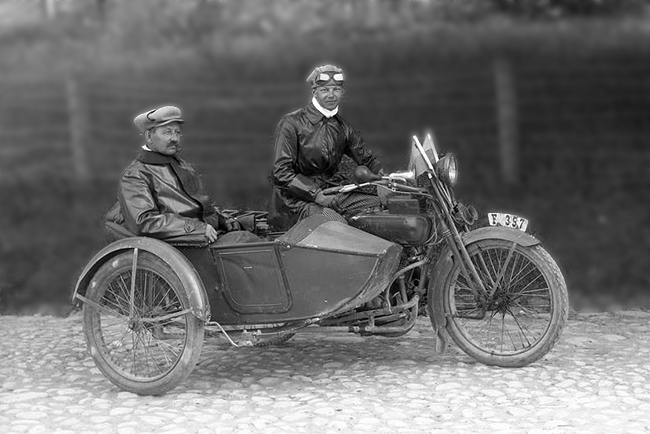While this November will mark the 50th anniversary of C.S. Lewis’ death, this weekend held a less significant anniversary year of an even more important event.
Eighty-two years ago on Saturday, Lewis took a fateful ride in a motorcycle sidecar to Whipsnade Park Zoo near Dunstable, UK.
The traditional date for Lewis’ conversion is September 28, 1931. In his excellent biography, C. S. Lewis – A Life: Eccentric Genius, Reluctant Prophet, Alister McGrath does raise the possibility that it actually happened in June of 1932, but in the end, he believes the traditional date is still probably the better option.
So what exactly happened on September 28 that led to Lewis completely his transition from atheists to Christian apologist? Not much, at least on that specific date. We have to move back a few days and even years to see the events that brought about the change.
First, many of Lewis’ literary influences unbeknownst to him at first, turned out to be Christians and prodding him along toward God. Poet George Herbert, one of the earliest fantasy writers George McDonald, and rhetorician G.K. Chesterton all were writing from a Christian perspective and much more winsomely, from Lewis’ perspective, than secular writers like George Bernard Shaw and H.G. Wells.
In seeing the imagination and “Joy,” which was a major theme of Lewis’ life, on the side of the Christians, Lewis was torn.
On the one side a many-islanded sea of poetry and myth; on the other a glib and shallow “rationalism.” Nearly all that I loved I believed to be imaginary; nearly all I believed to be real I thought grim and meaningless.
Surprised by Joy
This conflict ate away at Lewis until he had to give in and it was just that him resigning himself to the existence of some god.
I gave in, and admitted that God was God, and knelt and prayed: perhaps, that night, the most dejected and reluctant convert in all England.
Surprised by Joy
As Lewis embraced theism, he was not ready to accept Christianity or even the idea of a personal God. Yet, Lewis continued to be influenced by Christian friends, particularly Hugo Dyson and J.R.R. Tolkien. In February 3, 1930, Lewis writes to his non-Christian spiritualist friend Owen Barfield1Barfield held to anthroposophy, is “a spiritualist movement founded in the early 20th century by the Rudolf Steiner that asserted the existence of an objective, intellectually 2comprehensible spiritual world, accessible to human experience.” Those were wild times, apparently:
Terrible things are happening to me. The “Spirit” or “Real I” is showing an alarming tendency to become much more personal and is taking the offensive, and behaving just like God. You’d better come on Monday at the latest or I may have entered a monastery.
Letter to Owen Barfield, The Collected Letters of C.S. Lewis, Volume 1: Family Letters, 1905-1931
He did not want to take that final step, just as much as he did not want to take the first step.
What particularly concerned Lewis was the idea of God sending Jesus to die for our sins. What could that death thousands of years ago mean for our lives today? Lewis wasn’t wrestling with whether it was true, but whether it had meaning or significance.
On Saturday, September 19, 1931, Lewis had a long talk with Dyson and Tolkien as they strolled along Addison’s Walk.3Originally called Water Walk, Addison’s Walk is a picturesque footpath around a small island in the River Cherwell in the grounds of Magdalen College, Oxford, England (via Wikipedia). The two Christians were able to demonstrate to Lewis that Jesus’ resurrection is the True Myth. It is the mythical story that really happened.

Unbeknownst to him, the reason Lewis had felt such an affinity to all of the pagan myths is that they had slivers of truth in them. They were anticipations of the truth myth that was to come later. Similarities between Christianity and other religions don’t prove Christianity to be false, rather they give it even more credence.
Lewis wrote to his friend Arthur Greeves about that night.
I have just passed on from believing in God to definitely believing in Christ – in Christianity. I will try to explain this another time. My long night talk with Dyson and Tolkien had a good deal to do with it.
An October 1931 letter to Arthur Greeves, The Collected Letters of C.S. Lewis, Volume 1: Family Letters, 1905-1931
Nine days later, Lewis is being driven to Whipsnade Zoo by his brother Warnie on a motorcycle when everything changes for good. The line has finally been crossed.
I know very well when, but hardly how, the final step was taken. I was driven to Whipsnade one sunny morning. When we set out I did not believe that Jesus Christ is the Son of God, and when we reached the zoo I did.
Surprised by Joy
For Lewis, this changed everything. As he would later write in the essay “Christian Apologetics” from God in the Dock, “One must keep on pointing out that Christianity is a statement, if false, is of no importance, and, if true, of infinite importance. The one thing it cannot be is moderately important.”
It took a process for Lewis to arrive at the point where he recognized Christianity as truth, but once that was grasped, he was never the same. The sidecar ride to Whipsnade brought everything into focus for him and Christians have benefited from that moment for 82 years.
Here is a video tour of Addison’s Walk and the Fellows’ Garden with Garden Master Tim Barraclough and Dinah Rose, President of Magdalen College, in which they talk about Lewis’ walks with Tolkien around the path and show a poem Lewis wrote about Springtime on Addison’s Walk.


